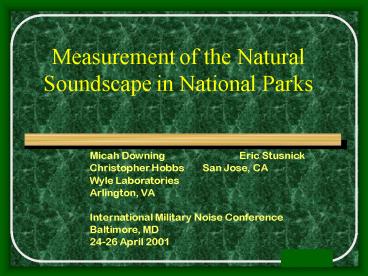Measurement of the Natural Soundscape in National Parks - PowerPoint PPT Presentation
1 / 20
Title:
Measurement of the Natural Soundscape in National Parks
Description:
'conserve the scenery and the natural and historic objects and the wildlife ... Soundscape -- the totality of all sounds in an area (natural & man-made sounds) ... – PowerPoint PPT presentation
Number of Views:148
Avg rating:3.0/5.0
Title: Measurement of the Natural Soundscape in National Parks
1
Measurement of the Natural Soundscape in National
Parks
Micah Downing Eric Stusnick Christopher Hobbs
San Jose, CA Wyle Laboratories Arlington,
VA International Military Noise
Conference Baltimore, MD 24-26 April 2001
2
National Park Service Organic Act of 1916
- NPSs responsibility
- conserve the scenery and the natural and
historic objects and the wildlife therein and to
provide for the enjoyment of the same in such
manner and by such means as will leave them
unimpaired for the enjoyment of future
generations - NPSs fundamental purpose
- conserve park resources and values
3
Natural Soundscape
- NPS has identified the natural soundscape as
one of the park primary resources. - Soundscape -- the totality of all sounds in an
area (natural man-made sounds) - Natural Soundscape -- only natural sounds and
excludes man-made sounds
4
Measurement Approaches
- Audibility-based Focuses on acoustic metrics
which describe the audibility to humans of
intruding noise sources - Energy-based Focuses on acoustic metrics which
describe the acoustic energy of the soundscape,
independent of whether or not intruding noise
sources are audible to humans
5
Signal Detection
- The probability of detecting an intruding sound
(signal) over a natural background sound (noise)
is a function of the signal-to-noise ratios in a
series of critical bands. - Above about 200 Hz, the critical bandwidths are
well approximated by one-third octave bands. - The probability of detection also depends on the
attentiveness of the listener.
6
Measurement of Audibility
- Require human listeners to detect when an
intruding noise can be heard - Shorter study periods
- Percent time audible
- Complex predictive models
- one-third octave band spectra of natural
soundscape - one-third octave band spectra of intruding noise
sources - each of which vary with time and position
7
Acoustic Energy-Based Metrics
- NPS L90 of the soundscape best represents the
natural soundscape sound levels - A-weighted or 1/3 octave band Leq measurements
- Monitor very long periods of time using automated
equipment - Transient event identification
- No indication of audibility of intrusive sounds
8
Zion NP East Rim Trail, Fall 2000
9
Transient Event Identification
10
Exceedance Levels of Natural Soundscapes
- Comparisons of the differences between total and
natural sound level distributions for
observer-based data taken at five different
national parks indicate - (L90)total (L90)natural 0.5 dBA
- (L50)total (L50)natural 1.5 dBA
- Thus estimates of the L90 of the natural
soundscape can be made from measurements of the
L90 of the total soundscape.
11
Probability of Exceedance vs. A-weighted Sound
LevelAnhinga Trail, Everglades National Park (NP)
12
Average Difference Between Total and Natural
Exceedance Levels for SID South Florida 1997 Data
13
Average Difference Between Total and Natural
Exceedance Levels for Volpe South Florida 1998
Data
14
Average Difference Between Total and Natural
Exceedance Levels for Zion NP 1998 Data
15
Average Difference Between Total and Natural
Exceedance Levels for Glacier NP 1998 Data
16
Average Difference Between Total and Natural
Exceedance Levels for Rocky Mountain NP 1998 Data
17
Comparison of Methodologies
- Audibility metrics
- Require listeners to determine audibility
- Spectra of natural soundscape and intruding
sources needed for modeling - Limited study periods
- Energy metrics
- Automated equipment can be used
- Sound levels of soundscape only
- Audibility of intrusions not determined
18
(No Transcript)
19
Conclusions
- Two approaches
- independent
- should not be convolved together
- complement each other
- Audibility-based approach
- better for assessing intrusions (human
perspective) - Intensive measurement requirements
- Energy-based approach
- better for defining acoustic characteristics of
natural soundscape independent of intrusions - long-term monitoring
20
Current Work
- Grand Canyon NP
- Audibility-based measurements (Sep 2000)
- Model evaluation
- Zion NP
- Long-term and seasonal energy-based monitoring
(Oct 2000 to Nov 2001) - Natural soundscape characterization
- Technical procedures development































